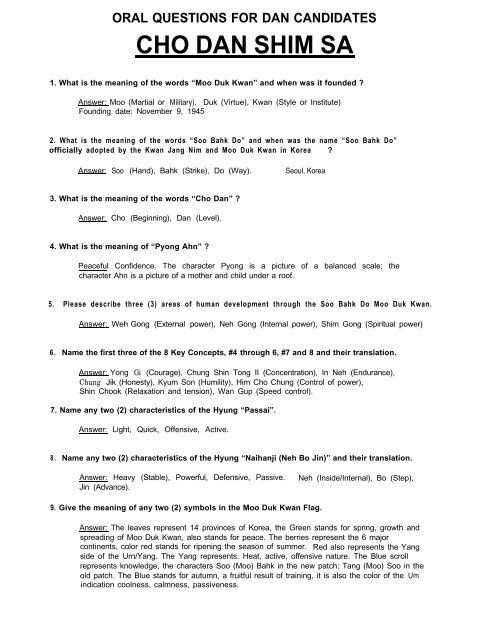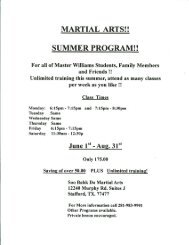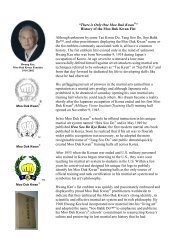oral questions for dan candidates - Soo Bahk Do™ Moo Duk Kwan ...
oral questions for dan candidates - Soo Bahk Do™ Moo Duk Kwan ...
oral questions for dan candidates - Soo Bahk Do™ Moo Duk Kwan ...
You also want an ePaper? Increase the reach of your titles
YUMPU automatically turns print PDFs into web optimized ePapers that Google loves.
ORAL QUESTIONS FOR DAN CANDIDATES<br />
CHO DAN SHIM SA<br />
1. What is the meaning of the words “<strong>Moo</strong> <strong>Duk</strong> <strong>Kwan</strong>” and when was it founded ?<br />
Answer: <strong>Moo</strong> (Martial or Military), <strong>Duk</strong> (Virtue), <strong>Kwan</strong> (Style or Institute)<br />
Founding date: November 9, 1945<br />
2. What is the meaning of the words “<strong>Soo</strong> <strong>Bahk</strong> Do” and when was the name “<strong>Soo</strong> <strong>Bahk</strong> Do”<br />
officially adopted by the <strong>Kwan</strong> Jang Nim and <strong>Moo</strong> <strong>Duk</strong> <strong>Kwan</strong> in Korea ?<br />
Answer: <strong>Soo</strong> (Hand), <strong>Bahk</strong> (Strike), Do (Way). Seoul, Korea<br />
3. What is the meaning of the words “Cho Dan” ?<br />
Answer: Cho (Beginning), Dan (Level).<br />
4. What is the meaning of “Pyong Ahn” ?<br />
Peaceful Confidence. The character Pyong is a picture of a balanced scale; the<br />
character Ahn is a picture of a mother and child under a roof.<br />
5. Please describe three (3) areas of human development through the <strong>Soo</strong> <strong>Bahk</strong> Do <strong>Moo</strong> <strong>Duk</strong> <strong>Kwan</strong>.<br />
Answer: Weh Gong (External power), Neh Gong (Internal power), Shim Gong (Spiritual power)<br />
6. Name the first three of the 8 Key Concepts, #4 through 6, #7 and 8 and their translation.<br />
Answer: Yong Gi (Courage), Chung Shin Tong II (Concentration), In Neh (Endurance),<br />
Chung Jik (Honesty), Kyum Son (Humility), Him Cho Chung (Control of power),<br />
Shin Chook (Relaxation and tension), Wan Gup (Speed control).<br />
7. Name any two (2) characteristics of the Hyung “Passai”.<br />
Answer: Light, Quick, Offensive, Active.<br />
8. Name any two (2) characteristics of the Hyung “Naihanji (Neh Bo Jin)” and their translation.<br />
Answer: Heavy (Stable), Powerful, Defensive, Passive. Neh (Inside/Internal), Bo (Step),<br />
Jin (Advance).<br />
9. Give the meaning of any two (2) symbols in the <strong>Moo</strong> <strong>Duk</strong> <strong>Kwan</strong> Flag.<br />
Answer: The leaves represent 14 provinces of Korea, the Green stands <strong>for</strong> spring, growth and<br />
spreading of <strong>Moo</strong> <strong>Duk</strong> <strong>Kwan</strong>, also stands <strong>for</strong> peace. The berries represent the 6 major<br />
continents, color red stands <strong>for</strong> ripening the season of summer. Red also represents the Yang<br />
side of the Urn/Yang. The Yang represents: Heat, active, offensive nature. The Blue scroll<br />
represents knowledge, the characters <strong>Soo</strong> (<strong>Moo</strong>) <strong>Bahk</strong> in the new patch; Tang (<strong>Moo</strong>) <strong>Soo</strong> in the<br />
old patch. The Blue stands <strong>for</strong> autumn, a fruitful result of training, it is also the color of the Um<br />
indication coolness, calmness, passiveness.
ORAL QUESTIONS FOR DAN CANDIDATES<br />
IO. When was Ki Cho Hyung IL Bu - Sam Bu created and by whom ? How many moves are in each<br />
<strong>for</strong>m ?<br />
Answer: 1947. <strong>Kwan</strong> Jang Nim Hwang Kee. 22 moves (Include Jhoon Bee and Ba Ro)<br />
11. What is the meaning of the words “Chil Song” and its related stars ?<br />
Answer: Seven Star. Big dipper with the North star.<br />
12. When was the U.S. <strong>Soo</strong> <strong>Bahk</strong> Do <strong>Moo</strong> <strong>Duk</strong> <strong>Kwan</strong> Federation founded and who is your Board<br />
member to represent you in your region ?<br />
Answer: June 28,1976<br />
13. What is the Um - Yang ?<br />
Answer: (Chinese: Yin - Yang) it is the symbol in the center of the Tae Kuk Gi (Korean flag). It<br />
is a symbol which reflects the Oriental view of the duality of the universe and how all things may<br />
be categorized as having one of two natures. Um is the blue side and represents the passive,<br />
coolness, defensive nature, and the female principle. Yang is the Red side and represents the<br />
active, heat, offensive nature, and the male principle.<br />
14. Whom in the Federation should you contact to if you have any concerns ?<br />
Answer: Elected Board member in my region (while observing proper protocol).<br />
15. What can you do to contribute to the success of our art of <strong>Soo</strong> <strong>Bahk</strong> Do <strong>Moo</strong> <strong>Duk</strong> <strong>Kwan</strong> ?<br />
Answer:personal. However it is important to see their indications related to<br />
to their Do Jang, Region, and the Federation.<br />
16. What do you feel is the main ingedient which differentiates a Martial Artist from someone who<br />
just practices Karate ?<br />
Answer: Understanding and applying <strong>Moo</strong> Do Shim Gong. Just because you can per<strong>for</strong>m the<br />
movements physically, does not mean you have an understanding of the spirit of the martial art.<br />
The spirit of the martial art (<strong>Moo</strong> Do Shim Gong) envelops all areas of a student’s ef<strong>for</strong>ts, on<br />
and off the training hall floor. To live like a martial artist is to be an artist of life and to apply the<br />
virtues and principles outlined in <strong>Kwan</strong> Jang Nim’s teachings.
ORAL QUESTIONS FOR DAN CANDIDATES<br />
EE DAN SHIM SA<br />
1. What is the motivation of name “Chil Song” Hyung ?<br />
Answer: “Buk Du Chil Song (Big dipper)” means” North head seven star”. The North star which<br />
was of great importance to early navigators. There are 7 hyungs in the Chil Song series. Each<br />
hyung has its own characteristic. <strong>Kwan</strong> Jang Nim Hwang Kee created the Chil Song hyungs<br />
and introduced them to help to guide us toward becoming better <strong>Moo</strong> Do practitioners.<br />
2. What is the literal meaning of the words “Neh Ga Ryu” and ‘Weh Ga Ryu” 7<br />
Answer: Neh (Inside/Internal), Ga (House), Ryu (Style).<br />
Weh (Outside/External). Ga (House), Ryu (Style).<br />
3. What is the meaning of “Ryu Pa” 7<br />
Answer: Literally, “River flows down divided”, it refers to the natural process of change which<br />
occurs as an art is practiced by human beings. The <strong>Kwan</strong> Jang Nim stresses, as should the<br />
<strong>candidates</strong>, that this is an unintentional process and it is not desirable to try to introduce<br />
impurities into the art.<br />
4. What does “Neh Khang Weh Yu” mean ?<br />
Answer: Neh (Inside), Khang (Strong I Hard), Weh (Outside), Yu (Gentle).<br />
5. What is the name of Yuk Ro Cho Dan hyung 3 And its meaning.<br />
Answer: “Du <strong>Moo</strong>n“. Du (Top / Great), <strong>Moo</strong>n (Gate).<br />
6. What have you experienced from Yuk Ro Hyungs and how have they helped you in your personal<br />
development ?<br />
Answer: Personal. However, following terms should be discussed by <strong>candidates</strong>; Neh Gong<br />
influence, Interaction with nature, Flow of energy...<br />
7. What is the “<strong>Moo</strong> Yei Do Bo Tong Ji” 7<br />
Answer: The <strong>Moo</strong> Yei Do Bo Tong Ji was published approximately 300 years ago. It is the only<br />
Korean martial art book known to have been written in that time period. It is the oldest and<br />
most valuable historical documentation of Korean martial arts.<br />
8. Why are you required to per<strong>for</strong>m the Ssang Bal Ahp Cha Nut Ki break ? What is the significance<br />
of this requirement and why ?<br />
Answer: At E Dan the practioner is required to per<strong>for</strong>m at a certain degree of proficiency with<br />
each side of his/her body. The Ssang Bal Chagi requires the practitioner to per<strong>for</strong>m this task<br />
simultaneously while several feet off the ground. This is a good test of this requirement. The E<br />
Dan should be able to not only per<strong>for</strong>m well with both sides of their body, but split their energy<br />
and focus all of their intent to two target areas at any given time.
ORAL QUESTIONS FOR DAN CANDIDATES<br />
9. Explain the significance of the Dan Bon.<br />
Answer: The Dan Bon is the number assigned to the <strong>Soo</strong> <strong>Bahk</strong> Do practitioner once he /she<br />
has achieved the rank of Cho Dan in the <strong>Moo</strong> <strong>Duk</strong> <strong>Kwan</strong>. It clearly defines the seniority and<br />
history of the practitioner within the <strong>Moo</strong> <strong>Duk</strong> <strong>Kwan</strong>. <strong>Kwan</strong> Jang Nim Hwang Kee is the only<br />
person who assigns Dan Bons and ensures that they are recorded in the <strong>Kwan</strong> Jok Bu (Book of<br />
Dan numbers).<br />
10. What is and who are the members of Technical Advisory Committee of the Federation 7<br />
Answer: The TAC is responsible <strong>for</strong> providing all the technical, historical, traditional, and<br />
philosophical gui<strong>dan</strong>ce of the <strong>Kwan</strong> Jang Nim to the Federation’s membership under the<br />
chairmanship of Hwang, Hyun Chul Sa Born Nim. Members of the TAC are appointed by the<br />
<strong>Kwan</strong> Jang Nim Hwang Kee. The TAC is comprised of the following Ko Dan Ja:<br />
1998 Chung, Hwa Yong Sa Born Nim<br />
1998 Seiberlich, Lawrence Sa Born Nim<br />
1998 Hanke, Russell Sa Born Nim<br />
1998 Martinov, Victor Sa Born Nim<br />
11. What is the role of the Board of Directors? Who is the Board member elected by you in your<br />
region.<br />
Answer: The Board is responsible <strong>for</strong> providing all administrative services necessary to ensure<br />
that the TAC can achieve its objectives. The Board is not only responsible <strong>for</strong> a business<br />
administration to the management of the Federation but moreover to the membership. As<br />
elected Board members their representation should be on behalf of the membership.<br />
12. What is the literal meaning of each word in “Yong Gi” (or other 8 Key concepts) ?<br />
Answer: Yong (Brave), Gi (Energy)<br />
Chung (Clean/Clear), Shin (God), Tong (Govern), II (One/First).<br />
In (Endure), Nae (Patience)<br />
Chung (Right), Jik (Straight).<br />
Kyum (Humble), Son (Humble).<br />
Him (Power), Jo (Manage), Chung (Right).<br />
Shin (Relaxation/Expend), Chook (Tention/Shrink).<br />
Wan (Loose/Slowness), Gup(Hurry/Fast).<br />
13. Please describe the process you utilized to prepare <strong>for</strong> this E Dan testing.<br />
Answer: Personal. However it is important to see that their preparations are connected with<br />
proper <strong>Moo</strong> Do chain.<br />
14. How will your role and/or responsibilities change if you are promoted to E Dan ?<br />
Answer: Personal. However it is important to see that their discussions are connected with<br />
proper <strong>Moo</strong> Do chain ( Seniors, Instructor, Do-Jang, Region, and Federation..).
ORAL QUESTIONS FOR DAN CANDIDATES<br />
15. What types of programs or activities would you like to see the Federation undertake to better<br />
serve its Dan members ?<br />
Answer: Personal.<br />
16. Why is loyalty to the <strong>Kwan</strong> Jang Nim and <strong>Moo</strong> <strong>Duk</strong> <strong>Kwan</strong> an important aspect of our training ?<br />
What does this means to you ?<br />
Answer: This is the highest level of <strong>Moo</strong> Do Shim Gong in loyalty. This will also ensure that the<br />
purity of our art, as well as our identity, is connected with the natural heritage and history of the<br />
<strong>Moo</strong> <strong>Duk</strong> <strong>Kwan</strong>.
ORAL QUESTIONS FOR DAN CANDIDATES<br />
SAM DAN SHIM SA<br />
1. Count from 11 - 15 in Korean and Chinese.<br />
Answer: Yohl Hana, Yohl Dul, Yohl Set, Yohl Net, Yohl Dasut.<br />
Ship Il, Ship E, Ship Sam, Ship Sa, Ship 0.<br />
2. What does “<strong>Moo</strong> Sang” and “Yu Sang” mean ? How does this philosophy apply to you ?<br />
Answer: 1. <strong>Moo</strong> (Nothing), Sang (Figure) = Invisible thing<br />
Yu (Exist), Sang (Figure) = Visible thing<br />
2. Personal. Things to consider a). Helps us to achieve balance in our actions and<br />
thoughts.<br />
b). Appreciate the values of <strong>Soo</strong> <strong>Bahk</strong> Do as <strong>Moo</strong><br />
Do both in our mind and body.<br />
3. What does “<strong>Moo</strong> Pahl Dan Khum” Mean ?<br />
Answer: Literally, <strong>Moo</strong> (Martial), Pahl (Eight), Dan (Level), Khum (Silk). The exercises<br />
introduced by the <strong>Kwan</strong> Jang Nim <strong>for</strong> better understanding of Neh Gong aspect of our training.<br />
4. There are two basic founding purposes of the Federation. What are they ?<br />
Answer: a). <strong>Moo</strong> Do Organization. b). Members Organization.<br />
5. What does “Sip Sam Seh” mean ? And what Sip Sam Seh does consists of ?<br />
Answer: Thirteen influence. It consists of “Pal-Gwe” (8 trigrams which indicated 8 directions)<br />
and “0-Heng” (5 essential elements of the universe).<br />
Pal-Kwe: 8 directions, S, N, E, W, SE, SW, NE,NW. - <strong>Moo</strong> Sang<br />
0-Heng: Hwa (Fire), <strong>Soo</strong> (Water), Mok (Wood), Khum (Metal), Toh (Earth) - Yu Sang<br />
6. How has the Song of the Sip Sam Seh in<strong>for</strong>med your <strong>Soo</strong> <strong>Bahk</strong> Do training ?<br />
Answer: The introduction of this song into the written documents of <strong>Soo</strong> <strong>Bahk</strong> Do is highly<br />
significant and must be acknowledged by all practitioners. This ancient song focuses the mind<br />
(heart) on the essence of martial arts training. The song describes both the ultimate goals of<br />
training and the essentials of how to achieve these goals. Each movement in my training needs<br />
to be in<strong>for</strong>med by the wisdom of the Sip Sam Seh philosophy in theory and application.<br />
7. What is the special meaning of the Yuk Ro Hyungs related to the culture and history of Korea ?<br />
Answer: The Yuk Ro Hyungs are translated by the <strong>Kwan</strong> Jang Nim from the ancient Korean<br />
martial arts manual which he discovered in the library of the Seoul National Uninversity in 1957.<br />
As such, they represent the <strong>Soo</strong> <strong>Bahk</strong> Ki of the authentic Korean traditional martial art. Their<br />
discovery and translation reconnects the Korean cultural present with it’s past. This reconnection<br />
is critical to an understanding of Korean culture and history.<br />
8. What is the name of Yuk Ro E Dan Hyung ? And its meaning ?<br />
Answer: “Joong Jol”. Joong (Middle I Center), Jol (Cutting).
ORAL QUESTIONS FOR DAN CANDIDATES<br />
9. How often do you personally train with your instructor?<br />
Answer:<br />
10. Please describe how you prepared yourself <strong>for</strong> this testing. Was your approach any different from<br />
your preparation <strong>for</strong> Cho Dan or E Dan ?<br />
Answer: Personal. However, it is important their preparation should be connected with the<br />
proper <strong>Moo</strong> Do Chain.<br />
11. What roles and responsibilities should a Sam Dan have in the Do Jang that differs from Cho Dan<br />
and E Dan?<br />
Answer: Personal. However, it is important to understand that as a senior Yu Dan Ja their<br />
roles and responsibilities should be connected with the proper <strong>Moo</strong> Do Chain.<br />
12. lf you successfully pass this examination, what kind of things will you undertake in the next year<br />
that will reflect upon your rank?<br />
Answer: Personal.<br />
13. What can you do to contribute to the success of our art of <strong>Soo</strong> <strong>Bahk</strong> Do?<br />
Answer: Personal<br />
14. What does “<strong>Moo</strong> Do Shim Gong” mean to you?<br />
Answer: Consider followings: Mental discipline, Mental and Physical application of the <strong>Moo</strong> <strong>Duk</strong><br />
<strong>Kwan</strong> philosophy in their actions, Understanding and upholding the values of history,<br />
traditions. and philosophy of the art and style, and Understand that loyalty is the highest level of<br />
the <strong>Moo</strong> Do Shim Gong.<br />
15. What is the proper protocol when a student visits another Certified Do-Jang of the Federation ?<br />
Answer: 1. They must notify their instructor be<strong>for</strong>e the visit takes place.<br />
2. Their instructor should call and make the hosting instructor aware of the<br />
student’s upcoming visit.<br />
3. Students should confirm their visit with the hosting instructor prior to visiting<br />
a Do-Jang.<br />
4. Students should respect the policies & guidelines of the hosting Do-Jang<br />
while visiting.





